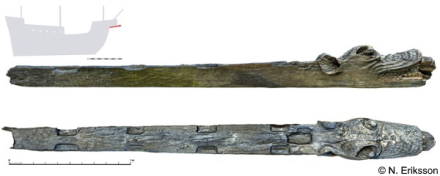History
The wreck was discovered in the 1970's by sport divers, but it was not until the early 2000's that the wreck was identified as the Danish carrack GRIBSHUNDEN, which headed the Danish royal fleet bound for Kalmar on a diplomatic mission in 1495. The ship caught fire and was lost. One of the decisive cues that led to the wreck's identification was the dog-like stem sculpture, which relates to the vessel's name (literally: "griffin-hound").

Niklas Eriksson
Description
The wrecksite has been also noted for the great quantities of weaponry, especially early gun carriages.
| Length | 114 ¾ feet (35 m) |
|---|---|
| Beam | 24 ½ feet (7.5 m) |
Status
The wreck is subject to ongoing maritime archaeological research.
References
- Riksantikvarieämbetet (Swedish National Heritage Authority).
L1978:2168 Fartygs-/båtlämning. - Rolf Warming (Combat Archaeology).
Gribshunden: Significance and Preliminary Investigations. - Eriksson, N. (2016).
Gribshunden (1495): vraket efter ett medeltida kravellskepp.
Marinarkeologisk tidskrift 1.
pp 4-10. - Eriksson, N. (2019).
Vraket efter Gribshunden (c. 1483-1495) – ett unikt exempel på medeltida skeppsarkitektur.
Forum Navale 75.
pp 80-91. - Eriksson, N. (2019).
Gribshunden – det sista drakskeppet?.
Gränsløs, 10.
pp 11-27. - Eriksson, N. (2020).
Figureheads and Symbolism Between the Medieval and the Modern: The ship Griffin or Gribshunden, one of the last Sea Serpents?.
The Mariner's Mirror 106.3.
pp 262-276. - Rönnby, J. (2015).
Gribshunden (1495): Skeppsvrak vid Stora Ekön, Ronneby, Blekinge. Marinarkologiska undersökningar 2013–2015.
Blekinge Museum & Södertörns University.